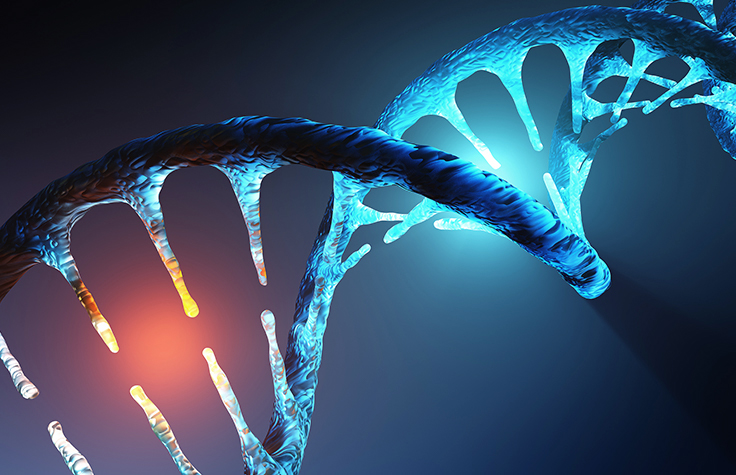The Gene in Evolution and Development
先达基因 / 2022-01-17
One of the more spectacular events in the history of twentieth-century biology as a discipline, triggered by the rise of genetics (mathematical population genetics in particular), was the so-called “modern evolutionary synthesis.” In a whole series of textbooks, published by evolutionary biologists like Theodosius Dobzhansky, Ernst Mayr and Julian S. Huxley, the results of population genetics were used to re-establish Darwinian, selectionist evolution.
After the “eclipse of Darwinism”, which had reigned around 1900 (Bowler 1983), neo-Darwinism once again provided a unifying, explanatory framework for biology that also included the more descriptive, naturalist disciplines like systematics, biogeography, and paleontology (Provine 1971; Mayr & Provine 1980; Smocoovitis 1996).

Scott Gilbert (2000) has singled out six aspects of the notion of the gene as it had been used in population genetics up to the modern evolutionary synthesis. First, it was an abstraction, an entity that had to fulfill formal requirements, but that did not need to be and indeed was not materially specified. Second, the evolutionary gene had to result in or had to be correlated with some phenotypic difference that could be “seen” or targeted by selection. Third, and by the same token, the gene of the evolutionary synthesis was the entity that was ultimately responsible for selection to occur and last across generations. Fourth, the gene of the evolutionary synthesis was largely equated with what molecular biologists came to call “structural genes.”
Fifth, it was a gene expressed in an organism competing for reproductive advantage. And finally, it was seen as a largely independent unit. Richard Dawkins has taken this last argument to its extreme by defining the gene as a “selfish” replicator with a life of its own, competing with its fellow genes and using the organism as an instrument for its own survival (Dawkins 1976; cf. Sterelny and Kitcher 1988).
Molecular biology, with higher organisms moving center-stage during the past three decades, has made a caricature of this kind of evolutionary gene, and has moved before our eyes genes and whole genomes as complex systems not only allowing for evolution to occur, but being themselves subjected to a vigorous process of evolution. The genome in its entirety has taken on a more and more flexible and dynamic configuration. Evelyn Fox Keller speaks of “reactive genomes” (Keller 2014). Not only have the mobile genetic elements, characterized by McClintock more than half a century ago in Zea mays, gained currency in the form of transposons that regularly and irregularly can become excised and inserted all over bacterial and eukaryotic genomes, there are also other forms of shuffling that occur at the DNA level. A gigantic amount of somatic gene tinkering and DNA splicing, for instance, is involved in organizing the immune response.
It gives rise to the production of potentially millions of different antibodies. No genome would be large enough to cope with such a task if not the parceling out of genes and a sophisticated permutation of their parts had not been invented during evolution. Gene families have arisen from duplication over time, containing silenced genes (sometimes called pseudogenes). Genes themselves appear to have largely arisen from modules by combination. We find jumping genes and multiple genes of one sort coding for different protein isoforms. In short, there appears to be a whole battery of mechanisms and entities that constitute what has been called “hereditary respiration” (Gros 1991, 337).
Molecular evolutionary biologists have scarcely scratched the surface and barely started to understand this flexible genetic apparatus, although Jacob already put forward a view of the genome as a dynamic body of ancestrally iterated and tinkered pieces more than thirty years ago (Jacob 1977). Genome sequencing combined with intelligent sequence data comparison is currently bringing out more and more of this structure (on the history of these developments, see García-Sancho 2012, on data-driven biology, see Stevens 2013). One of the surprising results of the Human Genome Project has been that there are only 21,000 genes. If there is a chance to understand evolution beyond the classical, itself largely formal, evolutionary synthesis, it is from such perspectives of learning more about the genome as a dynamic and modular configuration.
The purported elementary events on the basis of which the complex machinery of genome expression and reproduction operates—such as point mutations, nucleotide deletions, additions, and oligonucleotide inversions—are no longer the only elements of the evolutionary process, but solely one component in a much wider arsenal of DNA-tinkering. Beurton concludes from all this that the gene is no longer to be seen as the unit of evolution, but rather as its late product, the eventual result of a long history of genomic condensation (Beurton 2000). Others have argued that genomic analysis is not concerned with learning about genes as functionally or structurally defined units, but with “identifying causal relationships between parts of genomes and molecular products and identifying different” (Perini 2011).

Finally, recent years have seen a steady increase in evidence for epigenetic inheritance systems (Jablonka and Raz 2009, see also the entry on inheritance systems). This development has not only been promoted as a revolution in molecular biology, defining the post-genomic era (see Meloni and Testa 2014 for a discussion of the sociology of hype and expectation in this respect), but has led to yet another change in the concept of the gene, in so far as it can no longer be seen as the only unit of inheritance and selection and the primary cause in development.
While “epigenetics” refers more generally to processes of cell determination and differentiation — so called “epigenetic control systems,” — epigenetic inheritance “occurs when phenotypic variations that do not stem from variations in DNA base sequences are transmitted to subsequent generations of cells or organisms” (Jablonka and Raz 2009, 132).
While this can include developmental interactions between mother and offspring, social learning, symbolic communication, there is also a more narrow concept of cellular epigenetic inheritance. It refers to “the transmission from mother cell to daughter cell of variations that are not the result of differences in DNA base sequence and/or the present environment” (Jablonka and Raz 2009, 132). Cellular epigenetic inheritance systems discussed in the literature are the transmission of chromatin marks, especially DNA methylation, and RNAs, the inheritance of protein conformations, such as in prions, and self-sustaining loops and chromatin inheritance in bacteria. In multicellular organisms, especially the first type of mechanisms can explain how differentiated cells give rise to identical daughter cells even if the signal that initiated differentiation is gone.
But more important for the concept of heredity is cellular transgenerational epigenetic inheritance. In such cases “the environment may induce epigenetic variation by directly affecting the germline or by affecting germ cells through the mediation of the soma, but, in either case, subsequent transmission is through the germline” (Jablonka and Raz 2009, 133). This clearly implies that “the epigenetic body brings the Weismannian body to an end,” as Meloni and Testa (2014, 19) put it. Epigenetic variation can have phenotypic effects in the generation exposed to the stimulus, or in its offspring, which can persist for several generations.
This possibility opened a new field of interaction between biology and the social sciences, because factors in the human environment, from exposure to toxic compounds, via nutrition to education, can have epigenetic effects that span several generations. The idiom of epigenetics serves to biologize once more social and ethnic difference, and redefines individual vulnerability as well as responsibility and transgenerational accountability concerning effects of lifestyles on health and disease (Meloni and Testa 2014).
Furthermore, epigenetic inheritance in its broad as well as in its narrow meaning has significant consequences for the understanding of evolution and development (Jablonka & Lamb 2005). On the one hand, when combined with the idea of genetic assimilation (Waddington 1957), according to which genes are selected to fixate previous adaptive, but non-genetic variation, epiegenetic inheritance helps to explain how adaptive phenotypic responses become genetically fixed, suggesting neo-Lamarckian views of evolution (West-Eberhard 2003). On the other hand, the investigation of epigenetic mechanisms casts doubt on the causal or informational primacy of genes, or DNA. As a consequence genetic elements are treated on a par with other developmental resources necessary for the formation of a phenotypic trait. From this perspective, “genes” appear as processes resulting in phenotypic outcomes that involve a great number of other resources alongside DNA (Griffiths and Neumann-Held 1999).
This view is defended in accounts of Developmental Systems Theory (Oyama et al. 2001; Neumann-Held and Rehmann-Sutter 2006), although this theory has come under attack from philosophers for offering nothing “that aspiring researchers can put to work” (Kitcher 2001, 408; cf. Hall 2001). And, as Meloni and Testa have pointed out, while epigenetics counters gene-centered reductionism, it leads to a reduction of environmental influences to molecular agents. When scientists today speak of the exposome, the suffix ‐ome is indeed supposed to reflect the “digitization of all forms of environmental exposure, from motherly love to toxins, from food to class inequalities, into a single unifying category and syntax” (Meloni and Testa 2014, 18).
We have come a long way with molecular biology from genes to genomes to developmental systems. But there is still a longer way to go from genomes to organisms. The developmental gene as it acquired contours over the last twenty years from the early work of Ed Lewis and Antonio Garcia-Bellido, and from later work by Walter Gehring, Christiane Nüsslein-Volhard, Eric Wieschaus, Peter Gruss, Denis Duboule, and others, allows us possibly to go a step along on this way. As Gilbert (2000) argues, it is the exact counterpart to the gene of the evolutionary synthesis.
But we need to be more specific and direct attention to what have been termed “developmental genes” proper. As it turned out, largely from an exhaustive exploitation of mutation saturation and genetic engineering technologies, fundamental processes in development such as segmentation or eye formation in such widely different organisms as insects and mammals are decisively influenced by the activation and inhibition of a class of regulatory genes that to some extent resemble the regulator genes of the operon model. But in distinction to these long-known regulatory genes, whose function rests on their ability to being reversibly switched on and off according to the requirements of actual metabolic and environmental situations, developmental genes initiate irreversible processes. They code for so-called transcription factors which can bind to control regions of DNA and thus influence the rate of transcription of a particular gene or a whole set of genes at a particular stage of development.
Among them are what may be called developmental genes of a second order which appear to control and modulate the units gated by developmental genes of the first order. They act as a veritable kind of “master switch” and have been found to be highly conserved throughout evolution. An example is a member of the pax-gene family that can switch on a whole complex process such as eye formation from insects to vertebrates. Most surprisingly, the homologous gene isolated from the mouse can replace the one present in Drosophila, and when placed in the fruit fly, switch on, not mammalian eye formation, but insect eye formation. Many of these genes or gene families, like the homeobox-family, are thought to be involved in the generation of spatial patterning during embryogenesis as well as in its temporal patterning.
Morange (2000b) distinguishes two central “hard facts” that can be retained from this actually highly fluid and contested research field. The first is that the regulatory genes appear to play a central role in development as judged from the often drastic effects resulting from their inactivation. And second, it appears that not only particular homeotic genes have been highly conserved between distantly related organisms, but that they tend to come in complexes which have themselves been structurally conserved throughout evolution, thus once more testifying to genomic higher order-structures. Another class of such highly conserved genes and gene complexes is involved in the formation of components of pathways that bring about intracellular and cell-to-cell signaling. These processes are of obvious importance for cellular differentiation and for embryonic development of multi-cellular organisms.
One of the big surprises of the extensive use of the technology of targeted gene knockout has been that genes thought to be indispensable for a particular function, when knocked out, did not alter or at least did not significantly alter the organisms performance. This made developmental molecular biologists aware that the networks of development appear to be largely redundant, and that certain parts can compensate for eventually missing parts (Mitchell 2009, Ch. 4). These networks are obviously highly buffered and thus robust to a considerable extent with respect to changing external and internal conditions. Gene products are of course involved in these networks and their complex functions, but these functions are by no means defined by the genes alone.
Another result, coming from embryonic gene expression studies with recently developed chip technologies, was that one and the same gene product can be expressed at different stages of development and in different tissues, and that it can be implicated in quite different metabolic and cellular functions. Again, this multi-functionality of genes may help to rethink what genetic and biological determination means (see also the discussion of biological determinism in the entry on feminist philosophy of biology).
These recent results seriously call into question the further applicability of straightforward “gene-for” talk. The discovery of developmental genes throws light on the way in which the genome as a whole is organized as a dynamic, modular, and robust entity. Unlike the pieces of DNA with a determinate function as originally envisioned by molecular genetics, developmental genes appear as highly conserved in evolution, yet highly variable and redundant in function. They rather look like molecular building blocks with which evolution tinkers in constructing organisms—or with which organisms tinker in evolving. In recent years, evolutionary theories have come to acknowledge this active role of the organism in making use of, and even shaping highly conserved genetic mechanisms (West-Eberhard 2003; Kirschner & Gerhart 2005).





















